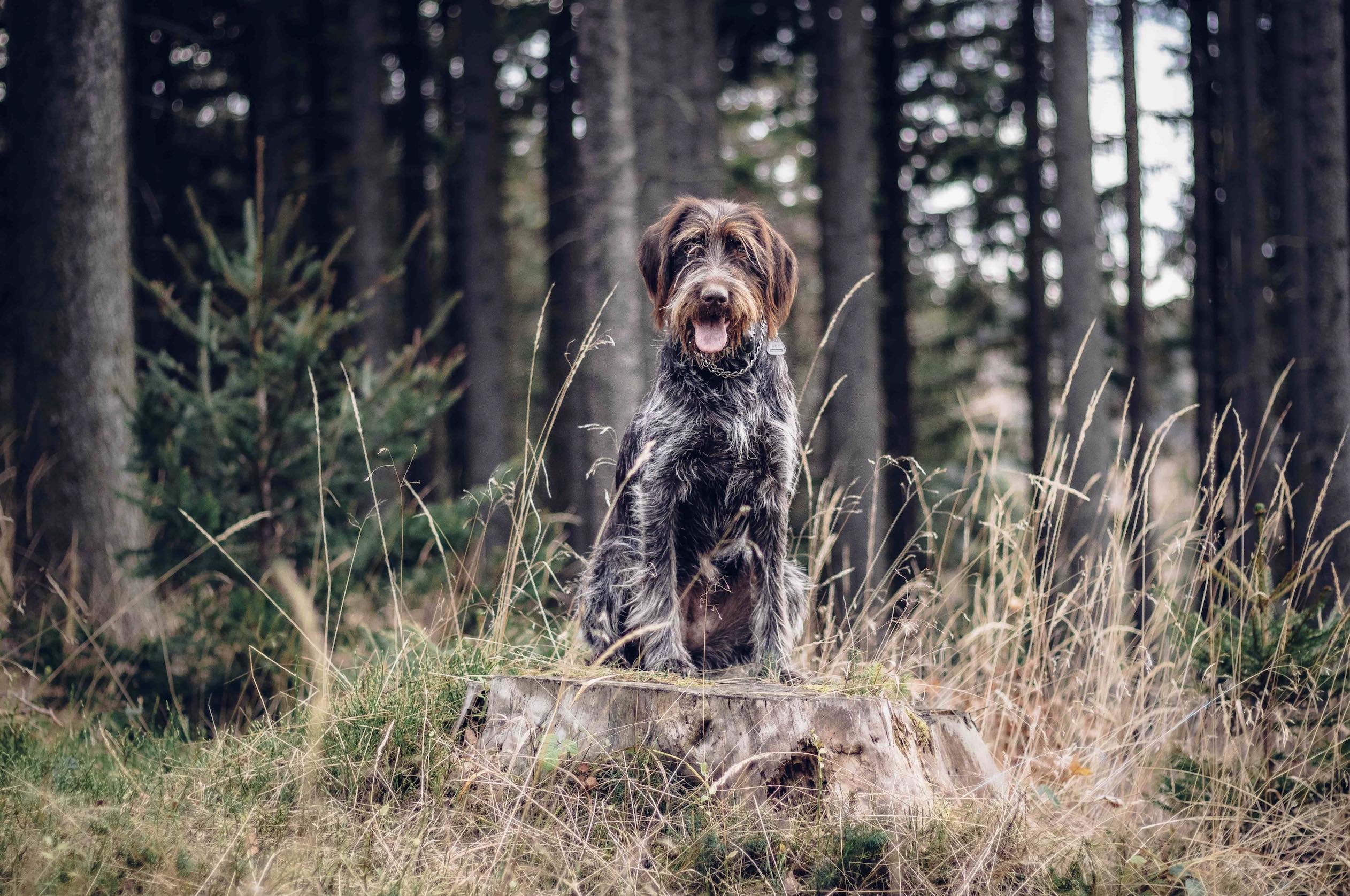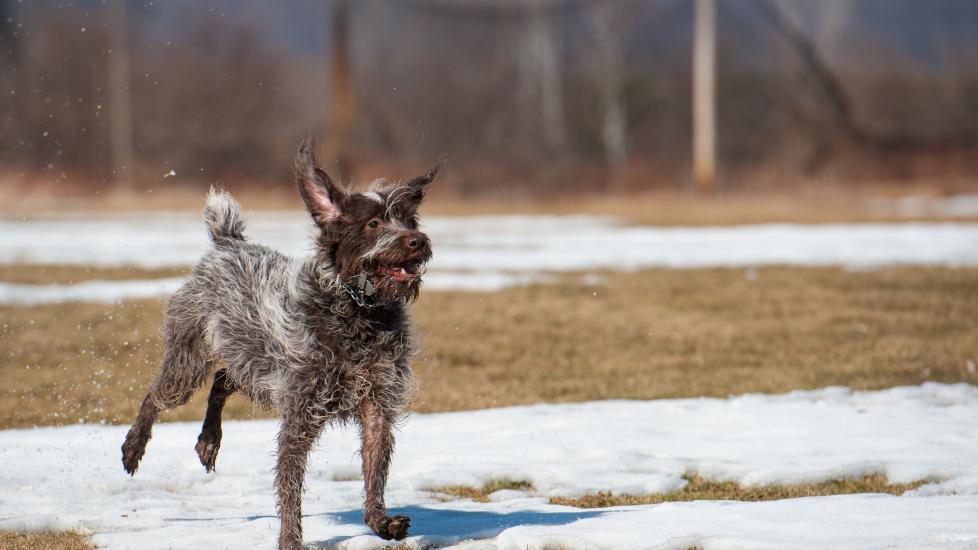Wirehaired Pointing Griffon
The Wirehaired Pointing Griffon is most well-known for their role as a hunting bird dog. The Griff, as they’re sometimes called, are smart dogs that desire to please their family.
They were bred in The Netherlands, but much of their development took place in France during the 1800s, according to the American Wirehaired Pointing Griffon Association (AWPGA). While Wirehaired Pointing Griffons were created to assist in hunting (both on dry land and in the water), they also make affectionate family members.
Caring for a Wirehaired Pointing Griffon
As a medium-size dog, Wirehaired Pointing Griffons stand 20–24 inches tall and weigh 35–70 pounds. They have a scruffy, wiry coat that comes in shades of gray and brown. Their coat doesn’t shed a lot and doesn’t require extensive grooming, though they’re not considered a hypoallergenic dog breed.
Griffon dogs are eager to please and work hard in the field. At home, these pups will cuddle closely to their family. Wirehaired Pointing Griffons are intelligent and respond well to positive reinforcement training. They are an active breed that needs lots of exercise and mental stimulation.
Wirehaired Pointing Griffon Health Issues
While there are a few health issues that pet parents should be aware of, the Wirehaired Pointing Griffon is generally a healthy breed. They have a typical lifespan of 12–15 years.
Hip Dysplasia
Hip dysplasia is a genetic disease wherein the hip joint doesn’t conform properly and becomes too loose, which then causes the cartilage and bone to wear down. As the body attempts to stabilize the joint, degenerative joint disease and osteoarthritis may develop. Arthritis, in turn, leads to pain, limping, and difficulty rising.
Maintaining a lean body condition is important for preventing arthritis in Wirehaired Pointing Griffons. Many vets recommend low-intensity exercise and joint supplements containing omega-3 fatty acids, glucosamine, and chondroitin for dogs diagnosed with hip dysplasia.
When pain is present, non-steroidal anti-inflammatory drugs (NSAIDs) are frequently prescribed to reduce inflammation and pain. If the pain from hip dysplasia cannot be managed, your vet may recommend surgery.
Progressive Retinal Atrophy
Progressive retinal atrophy (PRA) is a group of diseases that causes the photoreceptor cells (rods and cones) on the retina (the eye’s light-sensitive layer) to break down. Initially, the dog may have difficulty seeing in the dark. Over time, the dog will become blind. PRA is an inherited disease in most cases, and there are currently no effective treatments.
Cataracts
Cataracts occur more frequently in Wirehaired Pointing Griffons than in many other dog breeds. In most cases, the condition develops in older dogs as proteins and fibers in the lens of the eye break down, causing the lens to become cloudy. This leads to blurred vision, which can progress to blindness. This is an inherited condition in most cases, but cataracts can also be seen with diabetes mellitus or after an injury to the lens.
In some cases, cataracts cause inflammation and discomfort that requires medication. There are no effective medications to slow their progression or prevent vision loss. But cataracts can be surgically removed by a board-certified veterinary ophthalmologist, and the procedure usually restores vision.
Gastric Dilatation-Volvulus (GDV)
Gastric dilatation-volvulus (a severe form of bloat in dogs) is a condition that occurs suddenly and requires immediate life-saving intervention. GDV occurs when the stomach fills with food or gas, causing expansion and increased pressure. The stomach can then rotate, which causes inadequate blood supply to the organ. If not treated quickly, shock, tissue damage, and even death can occur.
Increased risk is seen in:
-
Older dogs with a deep chest (like the Wirehaired Pointing Griffon)
-
Dogs that are fed from elevated food bowls
-
Dogs that are fed only once per day
The longer a dog experiencing GDV goes without intervention, the greater the risk of death. Surgery is required to return the stomach to the right location and secure it in place.
A prophylactic gastropexy can be performed to prevent GDV. This surgery secures the stomach in the right position and keeps GDV from occurring. This is often done at the same time as spay or neuter surgery.
What To Feed a Wirehaired Pointing Griffon
Feeding your Wirehaired Pointing Griffon a food meeting the Association of American Feed Control Officials (AAFCO) nutritional standards is a good way to make sure they receive a complete and balanced diet. Talk to your veterinarian about the best food to feed your Griff, as it varies depending on your dog’s lifestyle, age, and health.
How To Feed a Wirehaired Pointing Griffon
Full-grown Griffon dogs should be fed twice a day. Wirehaired Pointing Griffon puppies need to eat three or four times every day to maintain a healthy blood-sugar level. Older dogs with deep chests should also be fed smaller meals more frequently to help decrease the risk of bloat.
Using a slow feeder bowl can help to pace your Griff when they eat, which can help prevent bloat and GDV. Do not feed your Wirehaired Pointing Griffon from a raised food bowl, as this can increase the risk of bloat and GDV.
How Much Should You Feed a Wirehaired Pointing Griffon?
A dog’s recommended caloric intake depends on their size, metabolism, neuter status, and activity level. The best way to determine how much to feed your dog is to talk with your veterinarian. The packaging on your AAFCO-compliant dog food will also provide portion guidance.
Maintaining a lean body and healthy weight is important for protecting a Wirehaired Pointing Griffon’s joints.
Nutritional Tips for Wirehaired Pointing Griffons
Though an AAFCO-compliant dog food will provide your pup with essential nutrients, Griffs can also benefit from the addition of omega-3 fatty acids (DHA/EPA) into their diet.
Omega-3 fatty acids can be found in skin and joint supplements, fish oil, and even in some
Behavior and Training Tips for Wirehaired Pointing Griffons
Wirehaired Pointing Griffon Personality and Temperament
Despite being bred as a hardworking hunter, the Wirehaired Pointing Griffon is a gentle dog. They are social pups that desire to spend time with and please their pet parents—especially during outdoor activities.
While all dogs (no matter the breed) and children should be supervised and taught how to interact with each other, Wirehaired Pointing Griffons are generally patient and gentle with children when socialized as puppies.
Wirehaired Pointing Griffon Behavior
Due to their history as bird dogs, this breed does best with a physical job that will keep their brain and body active. At a minimum, Wirehaired Pointing Griffons need 20 minutes of activity twice a day. If they are left alone too frequently and not given enough stimulation, they can develop separation anxiety and may even become destructive.
Despite being bred as a hardworking hunter, the Wirehaired Pointing Griffon is a gentle dog. They are social pups that desire to spend time with and please their pet parents.
Their hunting history also means these pups can have a strong prey drive. A Griff might see smaller animals, such as cats and rabbits, as something to chase. Introductions between this dog breed and smaller pets need to be done properly to ensure everyone gets along.
Wirehaired Pointing Griffon Training
Wirehaired Pointing Griffons desire to please their family. This, coupled with their high intelligence, makes them easy to train. They respond best to direct, concise instruction particularly when paired with game-oriented positive reinforcement.
Fun Activities for Wirehaired Pointing Griffons
- Obedience training
- Hiking
- Flyball
- Long walks
- Agility
- Hunting
- Nose work
Wirehaired Pointing Griffon Grooming Guide
The Wirehaired Pointing Griffon has a wiry outer coat and soft undercoat. Despite their double coat, Griffs are a low-shedding breed. They are relatively low-maintenance when it comes to grooming, but some at-home brushing and hand stripping is necessary.
Skin Care
Routine bathing helps maintain a Griff’s healthy skin but is only necessary a few times a year. Bathing your Griffon dog more than once a month can strip the skin of its natural oils.
Coat Care
The Wirehaired Pointing Griffon needs to be brushed weekly, and some individuals need to be hand stripped (a process where the hair is removed from the root instead of trimmed) routinely. According to the AWPGA, cutting the coat (instead of properly hand stripping) will make your Griff’s fur grow back “much fuzzier.”
Conditioning sprays can be helpful for maintaining a smoother coat. Trimming between the toes can help protect their paw hairs from becoming tangled and inflamed.
Eye Care
Wiping your Griffon dog’s eyes daily with a soft, moist cloth or pet-safe wipe will help remove debris. The hair around the eyes should be carefully trimmed to keep it from irritating the eyes. If squinting or eye discharge is noted, notify your veterinarian, as these can be signs of more serious eye conditions.
Ear Care
Cleaning the ears every one or two weeks for maintenance helps to prevent ear infections. If redness, odor, or debris is noted, an infection may be present and you need to consult your veterinarian.
Considerations for Pet Parents

The Wirehaired Pointing Griffon is a gentle, intelligent dog that’s eager to please. They love spending time with their humans and do not appreciate being left alone for extended periods. Under supervision, they are usually patient with young children. They require physical activity and mental stimulation, which can be best met by
Wirehaired Pointing Griffon FAQs
Do Wirehaired Pointing Griffons bark a lot?
The Wirehaired Pointing Griffon may bark to alert their family when someone is approaching. But when well exercised and mentally simulated, they aren’t known to be excessive barkers.
Do Wirehaired Pointing Griffons shed a lot?
The Wirehaired Pointing Griffon is a low-shedding breed. However, they do require some special grooming.
Is a Wirehaired Pointing Griffon a good family dog?
The Griff is a good family dog for those who are prepared to spend time exercising and playing with their pet, plus keeping them mentally engaged. The Griff is loyal to their family and aims to please, which makes them a relatively easy dog to train.
Featured Image: maureenjordan/iStock / Getty Images Plus via Getty Images
